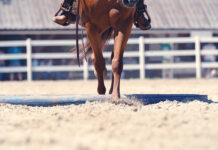
Sharp blades. “Even the most accomplished clipper can’t do a good job with dull blades,” Lyman says. If you’re clipping for that one big show—that means everything to you—spring for a new set of blades. Otherwise plan to resharpen your blades after two clip jobs; blades can be resharpened three or four times before they need to be replaced.
Extra blades. You shouldn’t really need these during one clip job, but you never know … always better to have a spare set just in case. Most blades snap onto clippers these days, but if yours require a screwdriver, have one of those handy, too.
A sturdy outdoor extension cord. Use a heavy outdoor extension cord that’s long enough to maneuver around your horse and remain out of the way.
Blade wash in a container, clipper oil and plenty of rags. As you start to clip, stop whenever the clippers feel hot or you hear the motor struggle. Dunk the clipper head in blade wash, with the motor running, then oil the blades. Next, rub a rag over the clipper blades and resume your work. Skipping this step strains the clipper’s motor, and letting your clippers run hot won’t be very pleasant for your horse, either. Spritzing your clipping blades with cooling lubricant spray, while the motor is on, also helps the blades cut smoothly.
A soft brush. As you clip, brush the piles of cut hair off your horse and out of your way.
A portable light. If the lighting in your clipping area isn’t ideal, you can purchase an inexpensive, portable flood light at any hardware store. Place the light and cord well away from your horse. Some clippers feature headlights, which help light the way as you clip.
A sturdy stepladder. If your horse is taller, you’ll need a higher vantage point when you clip his rump and back. Stand on something that’s sturdy and secure.
Tape or chalk to mark lines. Any sort of trace or partial body clip requires even, tidy lines to discern the areas of hair you’ll leave unclipped. You’ll clip steadier lines if you mark them first with masking tape or chalk on your horse’s body.
Back to Great Clips >>
This article originally appeared in the November 2007 issue of Horse Illustrated. Click here to subscribe.






great tips
Sounds perfect.